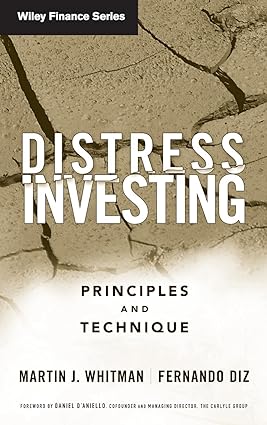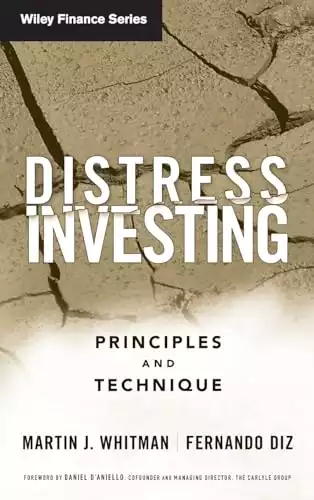Overview : Distress Investing
- Book Title: Distress Investing: Principles and Technique
- Author: Martin J. Whitman and Fernando Diz
- Publication Date: The book was first published in April 2009.
- price: $5.99
- Pages: 252
Overview of the Book
The author of Distress Investing, Martin J. Whitman, is a legendary value investor and founder of Third Avenue Management. Renowned for his deep understanding of distressed securities and his unique investment philosophy, Whitman shares his extensive experience in navigating challenging financial scenarios.
Introduction
In the ever-evolving world of finance and investment, distressed investing remains one of the most challenging yet potentially rewarding niches. "Distress Investing: Principles and Technique" by Martin J. Whitman and Fernando Diz offers a comprehensive guide to this complex domain, providing both theoretical insights and practical strategies for investors looking to navigate the turbulent waters of distressed assets.
Book Summary
Whitman, a renowned value investor, and Diz, a respected academic, combine their extensive experience and research to create a masterclass in understanding the intricacies of investing in distressed securities. The book delves deep into the principles and techniques essential for success in this high-risk, high-reward area of investing. Key areas covered include:
- Evaluating distressed securities
- Bankruptcy procedures and debt restructuring
- The role of hedge funds in distressed investing
- Various investment vehicles (distressed debt, equity, and special situations)
- Stages of distress and appropriate strategies for each
Analysis of Themes
Value Investing in Distressed Assets
The authors make a compelling case for why distressed investing can be a lucrative strategy, particularly during economic downturns. They argue that with the right approach, investors can identify undervalued assets and capitalize on market mispricing. Whitman's background as a value investor is evident throughout, as he consistently underscores the importance of intrinsic value and margin of safety.
Risk Management and Due Diligence
A recurring theme is the delicate balance between risk and reward. The authors emphasize the importance of thorough due diligence and a disciplined investment approach to mitigate risks. They also highlight the psychological aspects of investing in distressed assets, acknowledging that it requires a contrarian mindset and the ability to go against the crowd.
Market Analysis and Timing
The book provides valuable insights into market trends and timing, particularly in relation to economic cycles and their impact on distressed investing opportunities. This analysis is crucial for investors looking to capitalize on market inefficiencies and identify potential turnaround situations.
Writing Style
The authors present complex financial concepts in a clear and structured manner. While the content is technical and geared towards professionals and advanced students of finance, the use of real-world examples and case studies helps to illustrate abstract principles.
"The distressed investor must be prepared to weather extended periods of uncertainty and volatility. Success in this field requires not just financial acumen, but also patience and emotional discipline." - Martin J. Whitman
Strengths and Weaknesses
Strengths:
- Comprehensive coverage of distressed investing principles and techniques
- Insightful framework for evaluating distressed securities
- Practical application through real-world case studies
- In-depth analysis of bankruptcy procedures and debt restructuring
Weaknesses:
- May be too technical for beginners in finance
- Some examples and regulations may be outdated due to evolving financial landscape
- Limited discussion on the impact of recent trends like cryptocurrencies on distressed investing
Comparison to Other Works
While "Distress Investing" stands out in its niche, it's worth comparing it to other notable works in the field:
- "The Intelligent Investor" by Benjamin Graham: While Graham's classic focuses on value investing broadly, Whitman and Diz offer a more specialized look at distressed assets.
- "Investing in Distressed Debt" by Stephen G. Moyer: This book provides a complementary perspective, focusing more on the debt aspect of distressed investing.
Highlights from Distress Investing
- Distress investing: Focuses on investing in financially troubled or bankrupt companies.
- Opportunistic approach: Identifies undervalued assets in distressed situations with high return potential.
- Risk management: Emphasizes understanding the risks and complexities involved in distressed assets.
- Credit analysis: Stresses the importance of analyzing debt and financial structure before investing.
- Reorganization strategies: Discusses methods of turning around distressed companies for profit.
- Market inefficiencies: Explores how distressed investing capitalizes on market mispricings and investor panic.
Conclusion
"Distress Investing: Principles and Technique" is an invaluable resource for professional investors, financial analysts, and advanced students of finance looking to master the art and science of investing in distressed securities. Its combination of theoretical insights, practical techniques, and real-world case studies provides a comprehensive roadmap for navigating this complex field. While the book's technical content may be challenging for beginners, it offers a wealth of knowledge for those with a foundational understanding of finance and investment. The authors' expertise and attention to detail make this book a standout addition to the literature on financial investing. For those looking to expand their investment strategies and capitalize on opportunities in distressed markets, this book is a must-read. It equips readers with the tools and insights needed to succeed in the high-stakes arena of distressed investing.





